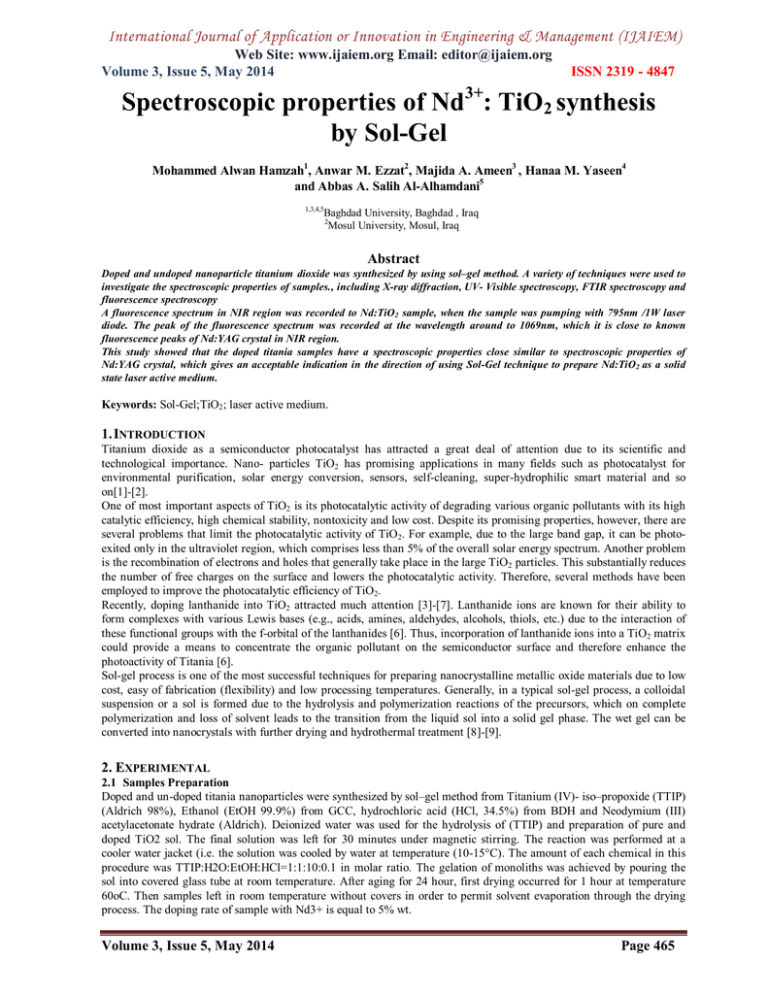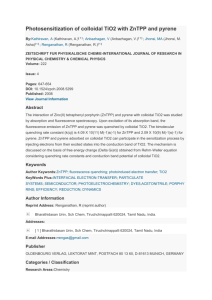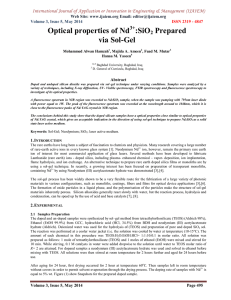International Journal of Application or Innovation in Engineering & Management... Web Site: www.ijaiem.org Email: Volume 3, Issue 5, May 2014
advertisement

International Journal of Application or Innovation in Engineering & Management (IJAIEM)
Web Site: www.ijaiem.org Email: editor@ijaiem.org
Volume 3, Issue 5, May 2014
ISSN 2319 - 4847
Spectroscopic properties of Nd3+: TiO2 synthesis
by Sol-Gel
Mohammed Alwan Hamzah1, Anwar M. Ezzat2, Majida A. Ameen3 , Hanaa M. Yaseen4
and Abbas A. Salih Al-Alhamdani5
1,3,4,5
Baghdad University, Baghdad , Iraq
2
Mosul University, Mosul, Iraq
Abstract
Doped and undoped nanoparticle titanium dioxide was synthesized by using sol–gel method. A variety of techniques were used to
investigate the spectroscopic properties of samples., including X-ray diffraction, UV- Visible spectroscopy, FTIR spectroscopy and
fluorescence spectroscopy
A fluorescence spectrum in NIR region was recorded to Nd:TiO2 sample, when the sample was pumping with 795nm /1W laser
diode. The peak of the fluorescence spectrum was recorded at the wavelength around to 1069nm, which it is close to known
fluorescence peaks of Nd:YAG crystal in NIR region.
This study showed that the doped titania samples have a spectroscopic properties close similar to spectroscopic properties of
Nd:YAG crystal, which gives an acceptable indication in the direction of using Sol-Gel technique to prepare Nd:TiO2 as a solid
state laser active medium.
Keywords: Sol-Gel;TiO2 ; laser active medium.
1. INTRODUCTION
Titanium dioxide as a semiconductor photocatalyst has attracted a great deal of attention due to its scientific and
technological importance. Nano- particles TiO2 has promising applications in many fields such as photocatalyst for
environmental purification, solar energy conversion, sensors, self-cleaning, super-hydrophilic smart material and so
on[1]-[2].
One of most important aspects of TiO2 is its photocatalytic activity of degrading various organic pollutants with its high
catalytic efficiency, high chemical stability, nontoxicity and low cost. Despite its promising properties, however, there are
several problems that limit the photocatalytic activity of TiO2. For example, due to the large band gap, it can be photoexited only in the ultraviolet region, which comprises less than 5% of the overall solar energy spectrum. Another problem
is the recombination of electrons and holes that generally take place in the large TiO2 particles. This substantially reduces
the number of free charges on the surface and lowers the photocatalytic activity. Therefore, several methods have been
employed to improve the photocatalytic efficiency of TiO2.
Recently, doping lanthanide into TiO2 attracted much attention [3]-[7]. Lanthanide ions are known for their ability to
form complexes with various Lewis bases (e.g., acids, amines, aldehydes, alcohols, thiols, etc.) due to the interaction of
these functional groups with the f-orbital of the lanthanides [6]. Thus, incorporation of lanthanide ions into a TiO2 matrix
could provide a means to concentrate the organic pollutant on the semiconductor surface and therefore enhance the
photoactivity of Titania [6].
Sol-gel process is one of the most successful techniques for preparing nanocrystalline metallic oxide materials due to low
cost, easy of fabrication (flexibility) and low processing temperatures. Generally, in a typical sol-gel process, a colloidal
suspension or a sol is formed due to the hydrolysis and polymerization reactions of the precursors, which on complete
polymerization and loss of solvent leads to the transition from the liquid sol into a solid gel phase. The wet gel can be
converted into nanocrystals with further drying and hydrothermal treatment [8]-[9].
2. EXPERIMENTAL
2.1 Samples Preparation
Doped and un-doped titania nanoparticles were synthesized by sol–gel method from Titanium (IV)- iso–propoxide (TTIP)
(Aldrich 98%), Ethanol (EtOH 99.9%) from GCC, hydrochloric acid (HCl, 34.5%) from BDH and Neodymium (III)
acetylacetonate hydrate (Aldrich). Deionized water was used for the hydrolysis of (TTIP) and preparation of pure and
doped TiO2 sol. The final solution was left for 30 minutes under magnetic stirring. The reaction was performed at a
cooler water jacket (i.e. the solution was cooled by water at temperature (10-15°C). The amount of each chemical in this
procedure was TTIP:H2O:EtOH:HCl=1:1:10:0.1 in molar ratio. The gelation of monoliths was achieved by pouring the
sol into covered glass tube at room temperature. After aging for 24 hour, first drying occurred for 1 hour at temperature
60oC. Then samples left in room temperature without covers in order to permit solvent evaporation through the drying
process. The doping rate of sample with Nd3+ is equal to 5% wt.
Volume 3, Issue 5, May 2014
Page 465
International Journal of Application or Innovation in Engineering & Management (IJAIEM)
Web Site: www.ijaiem.org Email: editor@ijaiem.org
Volume 3, Issue 5, May 2014
ISSN 2319 - 4847
2.2 Samples characterization
Structural characterizations for prepared samples were done by X-ray diffraction (XRD). θ–2θ scans were recorded using
ITAL-STRUCTURE diffractometer equipped. While Mid-IR spectra were obtained for the prepared samples using FT-IR
spectrometer, Shimadzu, on KBr pellets of the samples.
Absorption spectra were measured at room temperature with TupCen UV-VIS Spectrometer. Emission spectra were
measured at room temperature by using SolarLab monochromatore. As excitation source we used the 795nm/1W Laser
diode. Furthermore absorption and emission spectra were measured for Nd:YAG crystal to obtain a standard results.
3. RESULT AND DISCUSSION
The X-ray diffraction spectrums (XRD) were illustrated in Figure 1, and show that doped and undoped prepared samples
have amorphous structure [10], [11].
FTIR spectrums for the sample were illustrated in Figure 2. The peaks at 667 cm-1, 505 cm-1 and 447 cm−1 are attributed
to Ti–O bond. The peak at 667 cm−1 refers to symmetric O–Ti–O stretch while peak at 447 cm-1 and 505 cm−1 are due to
the vibration of Ti–O bond [12]- [14]. Another two bands were appeared at about 1600 cm-1 and 3400 cm-1 . These two
absorption bands are attributed to the characteristics vibration of O-H bond in water molecules [14], and indicating that
the drying process at 60ºC does not completely trap the water molecules from the pores of titania network.
Figure 1: XRD spectrums for prepared samples, (a) TiO2; (b) Nd:TiO2.
Figure 2: FTIR spectrums for doped and undoped samples, (a) Nd doped TiO2; (b)Pure TiO2.
UV/Vis absorption spectra, at room temperature, of Nd3+ doped monoliths are presented in Figure (3). The spectrum of
Nd:YAG is given for comparison. The enhanced absorption properties were mainly determined by the energy level
Volume 3, Issue 5, May 2014
Page 466
International Journal of Application or Innovation in Engineering & Management (IJAIEM)
Web Site: www.ijaiem.org Email: editor@ijaiem.org
Volume 3, Issue 5, May 2014
ISSN 2319 - 4847
structure of rare earth. The absorption spectrum of rare earth ions was due to electronic transitions caused by the energy
level. For the Nd:YAG, the absorption bands in the range of 450–850 nm corresponded to the energy level transition of
4
I9/2 →2G9/2 (481nm), 4I9/2→4G7/2 (531nm), 4I9/2→4G5/2 (588nm), 4I9/2→ 4F9/2 (684nm), 4 I9/2 →(4F7/2, 4S3/2) (735nm,
748nm) and 4 I9/2 →(4F5/2, 2H9/2) (795, 807nm), respectively[15]-[18].
For Nd3+:TiO2 sample, the Absorbance bands in the range of 450–850 nm corresponded to the energy level transition of
4
I9/2 →4G7/2 (518nm), 4 I9/2 →4G5/2 (575nm), 4I9/2→ 4F9/2 (678nm), 4 I9/2 →4F7/2 (739nm) and 4I9/2→4F5/2 (793nm)[5]-[6].
By comparison between two absorption spectrum, it could noted that some peaks of titania dopant sample are
mismatching with the peaks of Nd:YAG. That’s main the titania medium effect on the energy level of Nd3+ and forced the
energy level to divided into a sublevel difference from known sublevel of Nd:YAG. It’s clearly seen that the absorption
peaks band width of Nd:TiO2 are widely while Nd:YAG have a narrow absorption peaks. That’s because of amorphous
structure of prepared TiO2 samples. Most important result can be concluded from the absorption spectra is that the titania
dopant sample could be optically pumped in similar way of Nd:YAG optical pumping.
An important performance indicator for the sample to be useful for laser applications is its fluorescence properties. To
determine the optical characteristics of the samples, photoluminescence measurements were carried out using the
795nm/1W Laser Diode for excitation. The obtained spectrum is shown in Figure (4) for both of Nd:TiO2 and Nd:YAG
crystal. From Nd:YAG fluorescence spectrum it could observed a weak and broad peak around 1063nm with band width
of 11nm at full width half maximum (FWHM) [15]-[18].. While the Nd:TiO2 fluorescence spectrum have a weak and
broad peak at around 1069nm with band width of 18nm at FWHM. These two peaks correspond to the transition between
the levels 4F3/2 -4I11/2 of Nd3+ ion [4]-[7].
Absorption spectra are fundamental to determine the factors governing several optical properties, such as absorption
coefficients α(λ), absorption cross-sections σ(λ), and refractive index n(λ). σ(λ) can be calculated from the absorption
spectra of Nd3+:YAG and ND3+:SiO2 sample using the formula[19]:
σ (λ) = α (λ) /ρ -----(1)
Where ρ represent to ion density (cm-3 ).
Bowen and Wokes [20] gave empirical formula to get a sufficient accurate value of radiative lifetime τrad (in seconds):
1/τrad = 2900 n2 ύ2 ∫ε(ύ)dύ ------(2)
Where n is the refractive index of the material, ύ is the wavenumber at the peak of absorption band in µm-1 and ∫ε(ύ)dύ is
the area under the absorption band curve. ε(ύ) is molecular extincation coefficient [20]. The radiative lifetime τrad
calculated by eq. (2) refers to the spontaneous emission of light, and corresponds to the probability Anm (=1/τrad), that a
molecule will undergo a radiative transition from an upper state n, to a lower state m, in the absence of radiation of
frequency ν [20].
Figure (3): Absorption spectrums for; (a)Nd:TiO2, (b)Nd:YAG Crystal.
Peak emission cross-section (σp ) for lasing transition 4F3/2 -4 I11/2 can be determined from the relation [19], [21]:
Volume 3, Issue 5, May 2014
Page 467
International Journal of Application or Innovation in Engineering & Management (IJAIEM)
Web Site: www.ijaiem.org Email: editor@ijaiem.org
Volume 3, Issue 5, May 2014
ISSN 2319 - 4847
σp = λp4 / [8 π c ń2 Δλeff. τrad.] -------- (3)
where λp is the peak wavelength within the fluorescence band, Δλeff is the fluorescence linewidth (effective); which
determined by the full width half maximum (FWHM) of the fluorescence band and ń is given by [19]:
ń = [n2(λ) +2] 2 / [ 9 n(λ) ] -------- (4)
where n (λ) is Refractive index that can be expressed as [19]:
n (λ) = [4R / {(R+1)2- K2 (λ) }]1/2 – [(R+1)/(R-1)].-------- (5)
Where R is the reflectance of the absorbing medium (i.e. doped with RE3+ ions), and K is the extinction coefficient which
given by [19]:
K(λ)= λ α (λ)/4 π ---------------- (6)
Figure (4): fluorescence spectrums for, (a) Nd:TiO2 ; (b) Nd:YAG Crystal.
Table (1) present some results of measured and calculated parameters for Nd:YAG and Nd:TiO2 samples. The
parameters calculated to absorption band 4I9/2→4F5/2 and to fluorescence peak correspond to the transition 4F3/2 -4I11/2 of
Nd3+ ion.
Table 1. Optical properties parameters for Nd:YAG and Nd:TiO2 sample.
Parameters
Nd:YAG
Nd:TiO2
Radiative lifetime τrad ,(mS)
447
320
Emission Peak Wavelength (nm)
1063
1069
11
18
3.8*10-18
2.1*10-18
Linewidth FWHM (nm)
Emission Cross section (cm2)
The measured and calculated parameters to Nd:YAG are close to known parameters of Nd:YAG crystal [15]-[16]. That’s
gives a good indication about the accuracy of parameters measurements to doped titania. From Table (1), it can note that
parameters of Nd:TiO2 are somewhat close to parameters of Nd:YAG. That’s means the optical properties to prepared
doped sample are close similar to optical properties of Nd:YAG crystal. This result gives further more good indication in
direction of using Sol-Gel technique to prepare of Nd:TiO2 samples as solid state Laser active medium
Volume 3, Issue 5, May 2014
Page 468
International Journal of Application or Innovation in Engineering & Management (IJAIEM)
Web Site: www.ijaiem.org Email: editor@ijaiem.org
Volume 3, Issue 5, May 2014
ISSN 2319 - 4847
4. CONCLUSION
The sol-gel of Nd3+ doped Nanotitania is successfully prepared by wet chemical synthesis method. The doped and
undoped prepared Nanotitania samples seem to be transparent and unbroken which due to the suitable sol-gel parameters
used. The optical properties of doped samples are close similar to optical properties of Nd:YAG crystal. This suggests that
it could use Sol-Gel technique to prepare of Nd:TiO2 as solid state Laser active medium.
References
[1] Gupta, K.K., Jassal, M. and Agrawal, A.K. “Sol-gel derived titanium dioxide finishing of cotton fabric for self
cleaning”, Indian J. of Fibre Text. Res.. 33:443-450, 2008.
[2] M. A. Hamza, F. N. Saiof and A. S. Al-ithawi, “Prepared of Nd:TiO2 via Sol-Gel technique”, IJAIEM Vol.2, 7, pp
432 -436, 2013.
[3] S. I. Shah, W. Li, C.-P. Huang, O. Jung and C. Ni, “Study of Nd3+, Pd2+, Pt4+, and Fe3+ dopant effect on
photoactivity of TiO2 nanoparticles”, PNAS 99 (2) , 6482-6486, (2002).
[4] Mohammed A. Hamza, F. Saiof, A. Al-ithawi, M. Ameen and H. Yaseen, "Prepared of Nd: TiO2 Nano Particles
Powder as IR Filter via Sol-Gel," Advances in Materials Physics and Chemistry, Vol. 3 No. 2, pp. 174-177, 2013.
[5] W. Li , Y. Wang ,H. Lin,S. I. Shah ,C. P. Huang, D.J. Doren ,S.A. Rykov ,J.G. Chen and M.A. Barteau, “Band gap
tailoring of Nd3-doped TiO2 nanoparticles” , Appl Phys Lett , 83:4143-4145, (2003).
[6] Hyung Sun Kim, Yu Bao Li and Soo Wohn Lee,” Nd3+ Doped TiO2 Nanoparticles Prepared by Sol-Hydrothermal
Process”, J. Materials Science Forum, 510-511, 122, 2006.
[7] Chen X, Luo W. , “Optical spectroscopy of rare earth ion-doped TiO2 anophosphors.” J Nanosci Nanotechnol.
Mar;10(3):1482-94, 2010.
[8] Livage J., Henry M. and Sanchez C., “Sol-gel chemistry of transition metal oxides,” Prog. Solid State Chem., , 18(4):
259-342, 1988.
[9] C. Jeffrey Brinker , George W. Scherer “The PHYSICS AND CHEMISTRY of Sol-Gel processing”, SOL-GEL
SCIENCE Academic press,(1990).
[10] A. Burns, G. Hayes, W. Li, J. Hirvonen, J. D. Demaree and S. I. Shah, “Neodymium ion dopant effects on the phase
transformation in Sol-Gel derived titania nanostructures”, Materials Science and Engineering B111, 150-155,
(2004).
[11] J.Thomas, Praveen K., Mathew S.,” Hydrothermal Synthesis of Samarium Doped Nanotitania as Highly Efficient
Solar Photocatalyst ,” Sci. Adv. Mat., 2, 481-488 (2010).
[12] N. Hadi, “Modification of titanium surface species of titania by attachment of silica nanoparticles, Materials Science
and Engineering B 133, pp 49–54 (2006).
[13] A. Merouani and H. Amardjia-Adnani "Spectroscopic FT-IR study of TiO2 films prepared by sol-gel method,"
International Scientific Journal for Alternative Energy and Ecology, 6 (62) 151-154, (2008).
[14] K. Young-Geun, Se-Young Choi, Eul-Son Kang and Seung-Su Baek "Ambient-dried silica aerogel doped with TiO2
powder for thermal insulation", JOURNAL OF MA-TERIALS SCIENCE, 35 6075 – 6079, 2000.
[15] W. Koechner, "Solid State Laser Engineering", Springer Series in Optical Sciences, Vol.1, 5th ed., New York,
(1999).
[16] Marvin J. Weber, “Handbook of Lasers” , CRC Press LLC, (2001).
[17] D. K. Sardar, D. M. Dee, K. L. Nash, R. M. Yow, and J. B. Gruber, J. Appl. Phys. 100(12), 123106, (2006).
[18] CHEN Jiao , ”Preparation and properties of Nd:YAG ultra-fine powders”, JOURNAL OF RARE EARTHS, Vol. 29,
No. 1, p. 44,. 2011.
[19] Firas J. K., “PREPARATION AND STUDY OF RARE EARTH LASER ACTIVE MEDIA USING SOL-GEL
TECHNIQUE”, Ph. D. thesis, Baghdad University , (2009).
[20] C. A. Parker, "Photoluminescence of Solutions", Elsevier, Amsterdam, pp. 25-27, (1968).
[21] Hongxu Zhou, Qivhong Yang , J.Xu,H.Zhang, J.Alloys comped .,vol.471,pp.474-476. 2009.
AUTHOR
Mohammed Alwan Hamzah received the B.Sc. and M.Sc. degrees in Physics from Baghdad Uni. (Iraq) in
1986 and 1999, respectively. During 1996-1999, he stayed in college of science to study Optoelectronics, Laser
and Digital Image processing. In 2014 he received the Ph.D. degree from Mosul University, (Iraq). He works
now at the college of science, Baghdad University.
Volume 3, Issue 5, May 2014
Page 469






